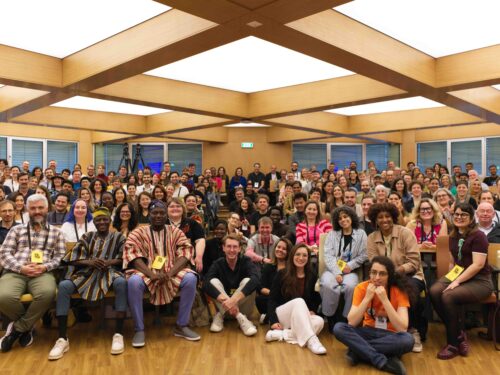A few weeks ago, I made my way to Lisbon, Portugal to attend the GLAM Wiki Conference 2025 hosted by WikimediaPT, Wiki Editoras Lx, the Wikimedia Foundation, Wikimedia Brasil and several other amazing folks. Never heard of the GLAM Wiki Conference and wondering how there could possibly be another Wiki-related conference? I’m sure you’re not alone! But what makes this conference worth a trip across the world?
Simply put, the chance to connect with an incredibly diverse group of cultural heritage organizations and practitioners. The GLAM in the name? That’s an acronym that stands for Galleries, Libraries, Archives, and Museums, which only begins to describe the attendees of this conference. The goal of the conference is to create this happy mix of passionate people, learn how all of us can better work within our respective Wiki-communities, and explore this year’s theme of resilience. Forty presentations, several keynotes, breakout sessions, and demos, seen by around 200 participants, were spread out over three days at the Iscte — Instituto Universitaria de Lisboa.

Resilience, the theme, was resonant this year as many institutions worldwide have experienced significant challenges this past year. Whether in staffing, mission, vision, outside pressure, preservation, audience, tools, time or anything else, survival, sustainability, and the ability to continue to serve communities all remain urgent goals.
This particular slice of the Wiki world is an interesting one as their projects tend to spread across several Wikimedia projects — Wikipedia, Wikidata, Commons and many others. This unique cross-section presents some interesting opportunities and challenges.
To me, one of the most important parts of this conference was the fact that so many attendees come from institutions with a built-in and invested audience. For example, art museums have visitors. Archives have researchers. Governments have their citizens. Editing in the Wiki world comes on top of the investment these institutions make within their respective communities To serve their communities as well as contribute to the Wiki world, the conference attendees continuously work to make their collections make sense for their museums and for Wikipedia or Wikidata. This adds a sense of application and immediacy to the work. The scale of the collections represented at the conference ranged from 100 significant Basque objects to countrywide heritage portals in Chile and global coordination efforts across hundreds of museums, collections, and millions of records.
The conference also provided the unique opportunity to explore the tools necessary for representing cultural heritage in the Wiki world — image uploading, batch edits, mapping, visualizing and more. Some new tools I learned about ranged from a tool called Tapestry that provides an in-browser multimedia experience for users to full toolkits for new institutions to implement for successful projects. There were also the perpetual topics of tool support, development, and maintenance. Given the nature of these projects, these tools must be resilient.Tooling remains an ongoing conversation.
And what would a conference in 2025 be without several sessions devoted to artificial intelligence? I attended one talk that featured some cool scripts and tools for Wikimedia Commons, serving up automatic ALT-text and sorting images based on user input. Several of the keynotes made reference to AI challenging the status quo for cultural heritage museums. One significant concern was regarding harvesting and ingesting institutional datasets en masse, which attributes little to nothing back to the museums and essentially cuts the museums out of the conversation for people who use AI tools to access what began as museum data. This is destabilizing and I, along with the rest of us at the conference, hope this dynamic changes.
But destabilization wasn’t my only takeaway. In other talks, several speakers pointed out that the best way to address these changes is to put people at the center of conversations about AI and cultural authority. Institutions have always put people first. People are where cultural heritage comes from, and why we visit museums. Between their collections, audience, and staff, these organizations know that with people, everything is possible. So, making AI work for everyone involved seems like a good way to frame things. For all the challenges we currently face and will face in the future as a community, I can’t think of a better tool to help us through these challenging times than each other.
The GLAM Wiki Conference covered a lot of big, difficult topics. Resilience was an important, prescient theme for this year and will continue to be. Technology in the hands of people who know how to use it for other people feels pretty great. And you couldn’t ask for a better set of organizers and host country. It was wonderful to learn and connect with the hosts and other participants in Lisbon. I had a lot of fun with everyone, which might explain why after attending, I feel refreshed, ready to jump into a new year of GLAM projects.
